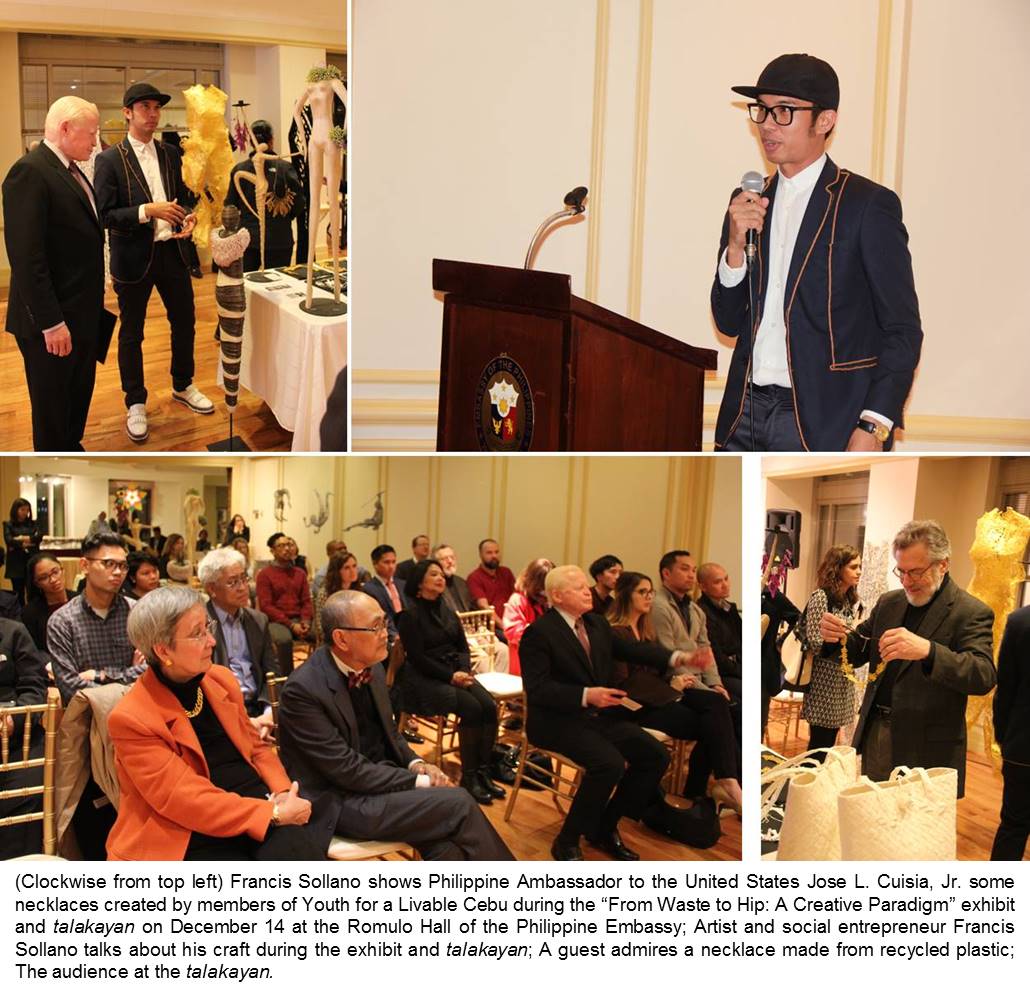
Francis Sollano, a 28 year-old visual artist and self-made social entrepreneur from Cebu, is making waves in the international fashion scene with his innovative pieces made from upcycled trash. A portmanteau of trash and fashion, the trashion movement has helped mobilize the local community and has empowered women and youth.
Sollano traveled to Washington, DC to showcase his work and share his story during a talakayan and exhibit entitled “From Waste to Hip: A Creative Paradigm” on December 14 at the Philippine Embassy.
Featured in the exhibit were statement dresses, bags, dolls, jewelry, and sculptural pieces made from recycled trash such as plastic bags, PET bottles, drinking straws, and sticker paper.
During the exhibit opening, Philippine Ambassador to the United States Jose L. Cuisia, Jr. talked about the significance of Sollano’s art at a time of climate vulnerability.
“Tonight’s event is in support of the Philippine and global vision on sustainable development and climate change adaptation,” said Ambassador Cuisia.
“Francis and the Youth for a Livable Cebu are showing us the way from Waste to Hip. Upcycling is the new wave of sustainable fashion. It produces beautiful and original works from what are often considered waste materials. The new term trashion is truly an apt description of what this exhibit is about. However, as you look around tonight, I want you to think of the significance of displaying these crafts that represent not only a means of livelihood but also a labor of love and expression of creativity in the midst of material scarcity,” said the Ambassador.
The motivation for using trash came from a love for the environment and an experience Sollano had three years ago while driving home in heavy rain.
“Three years ago while I was driving, my car’s carpet started to wave. It was then that I realized that it was flooding after just a few minutes of rain. Aside from the kids bathing in the flood rain, garbage was also all over the place. It was a painful picture. I immediately felt the urge to do something about it in the way I feel most comfortable—trashion,” said Sollano.
He added, “It was never a difficult decision to choose trash as material. It is painful to see garbage littered all over our cities, much worse seeing Filipinos throw their garbage in the streets as if our country is a huge trash bin. I wish to re-ignite a culture that truthfully values our environment and to take responsibility over our waste. It would be a very beautiful country to live in with products that speak the language of the earth.”
Creating fashion and art pieces from trash is no longer a solo endeavor for Sollano. Through a partnership with the non-profit Youth for a Livable Cebu (YLC), local communities have become an integral part in Cebu’s trashion scene.
“I can recall my childhood playing with candy wraps and turn them into trinkets. It was when I joined YLC that I started to take trashion seriously. YLC, as a youth group, advocates for sustainability and part of its programs is upcycling. I saw this as a wonderful platform to introduce my art pieces and network with commercial establishments,” said Sollano.
Women also play an active role in the production process. According to Sollano, trashion has allowed the women of the community to not only earn an income but also to rediscover their worth.
“Under YLC’s pillar of Work, the social enterprise of trashion aims to provide alternative sources of income to women from financially deprived communities. During one of our evaluations, we found out that most women felt happier about the exercise because they had found a new sense of worth in themselves, that they are able to contribute in their community and produce designs that are beautiful for the world to own. Instead of having a routinely lazy day, the women now enjoy creating trashion. Money has become secondary,” said Sollano.
Although trashion is a fairly new concept, Sollano believes there is a lot of potential for it to become a thriving industry.
“The future of trashion is very promising, most especially with the new consciousness that the upcoming designers bring with them. There are also fashion brands that have started to adopt the same principles of upcycling. For our brand, we hope to preserve its aesthetic with its products as pieces of art while we aim to grow its reach in different regions across the globe,” said Sollano.
YLC is the youth arm of the Movement for a Livable Cebu (MLC). Started in June 2012, the MLC is a network of young professionals and volunteers collaborating in creative and sustainable ways to make Cebu a better place to live in.
Earlier this year, the Embassy featured Philippine hand-woven fabric and the Grand Dame of Philippine Fashion, Ms. Patis Tesoro. From Waste to Hip: A Creative Paradigm caps off 2015 as a year of Philippine textiles, design and fashion.
Talakayan sa Pasuguan is the Embassy’s ongoing forum series which serves as a venue for the discussion of timely and relevant issues that affect the Filipino-American community. END

